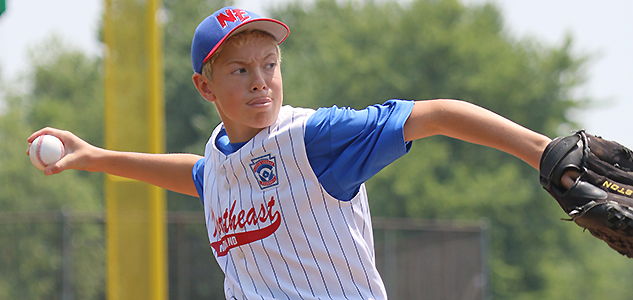Youth baseball pitching injuries are on the rise. The world-renowned Dr. James Andrews describes the increase in injury rates as an epidemic (ESPN interview). His research shows 5% of youth pitchers will have at least 1 serious elbow or shoulder injury that will require surgery or end their career. Historically, throwing curveballs at a young age was thought to ruin playing careers. However, the latest research shows arm fatigue, not spinning curveballs, is the primary reason for the sharp rise in youth pitching injuries.
Should Youth Pitchers Throw Curveballs?
Dr. Andrews and his team at the American Sports Medicine Institute in Birmingham, Alabama tracked 481 youth baseball pitchers (ages 9 to 14) for 10 years. Pitchers were interviewed annually to track any serious injury. They also tracked pitching volume and pitch type. Serious injury was defined as one requiring surgery or ending an athlete’s career.
Pitching more than 100 innings in 1 year significantly increased the risk of a serious elbow or shoulder injury by 3.5 times. Throwing curveballs before the age of 13 did not significantly increase the risk of injury. This study suggests the number of innings pitched in games, not the type of pitches thrown, is a major concern.
Throwing with Arm Fatigue is a Recipe for Injury
Another 2006 study from Dr. Andrews group identified the following risk factors for shoulder or elbow surgery in youth baseball pitchers:
- Pitching 8 or more months per calendar year (5 times more likely to sustain a serious injury)
- Throwing 80 or more pitches per appearance (3.8 times more likely)
- Throwing velocities greater than 85 mph (2.5 times more likely)
- Regularly pitching with arm fatigue (36 times more likely)
Research from the Journal of Strength and Conditioning Research found throwing accuracy and arm soreness to be closely associated with arm fatigue. Throwing velocity is associated with generalized fatigue, not isolated arm fatigue.
Therefore, youth athletes should be closely monitored by coaches to gauge arm fatigue and throwing-induced injury risk. Throwing accuracy, and not velocity is probably the more important variable to monitor in order to reduce injury risk. Also, regularly communicating with athletes about arm soreness is crucial to reduce the risk of youth baseball pitching injuries.
What Coaches and Parents Should Know About Youth Baseball Pitching Injuries
Parents and coaches should closely monitor youth pitchers for signs of arm fatigue and soreness and discourage throwing year-round. A minimum of 2-3 months without throwing is recommended (more from Dr. Andrews).
During this active recovery period, athletes should work on other baseball skills and play other sports. Also, it is never too early to do strength and conditioning to improve athleticism. The off-season is the ideal time for an athlete to work with a strength coach to develop strength and power.
Contrary to popular belief, throwing breaking pitches at an early age is not going to blow your child’s arm out. We do not encourage kids to spin breaking balls at an early age but this is not our main concern.
The Stop Sports Injuries website has posted some other valuable youth baseball pitching injury prevention tips here. Bottom line: Closely monitor your athletes for signs of arm fatigue. These are complaints of soreness and loss of throwing accuracy.

